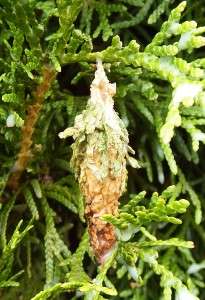The Hidden Bag Worm
Categories: News
Some insects that feed on the plants in our landscapes are not that damaging. We are not necessarily concerned about caterpillars that do a little nibbling on a few leaves and then turn into a beautiful butterfly or moth. We need to let these ‘friends’ eat their few leaves and develop, so we are helping mother nature and enjoying the beauty around us. What we need to be concerned about are insects that harm our plants and give us nothing of value in return. Some of these pests, if allowed to go unchecked, can ruin a plant and actually kill it. They don’t produce anything we can eat (like honey) and they don’t pollinate flowers that will produce edible fruit or vegetables. These harmful bugs destroy the foliage by eating it or sucking the juices to the point that the plant is so weakened it eventually dies or is so unsightly it must be removed.
Some examples of insects that cause major damage are mites that can devastate spruce, junipers, boxwood and many others. Then there are the borers, like the Emerald Ash Borer(EAB) which has killed thousands of ash trees, and other borers that affect dogwoods, peach and cherry trees. The critter we want to talk about today is the Bag Worm, not to be confused with Tent Caterpillars or the Fall Web Worm which are annoying but do not cause any long lasting damage to trees.
 The bag worm, pictured here, is many times mistaken for a pine cone on spruce, pines, arborvitae and other evergreens. Bag worms begin to hatch and start their munching in late May or by mid-June. When they hatch and begin to develop they can hardly be seen, but in just a couple of weeks they can do some serious damage. Mother Nature has provided this insect with a casing that is hard to spot because it is made of a very tough silk type thread and some of the foliage from the plant itself. This “home” moves along with the young worm and is very well camouflaged. The casing is so impervious that pesticides used to kill the insect will not penetrate it.
The bag worm, pictured here, is many times mistaken for a pine cone on spruce, pines, arborvitae and other evergreens. Bag worms begin to hatch and start their munching in late May or by mid-June. When they hatch and begin to develop they can hardly be seen, but in just a couple of weeks they can do some serious damage. Mother Nature has provided this insect with a casing that is hard to spot because it is made of a very tough silk type thread and some of the foliage from the plant itself. This “home” moves along with the young worm and is very well camouflaged. The casing is so impervious that pesticides used to kill the insect will not penetrate it.
The young insect moves about by swinging from plant to plant, soon after hatching, on a silk like thread that blows in the wind. Timing of pesticides is critical to control this insect. If the bagworm is not controlled when young - while it is coming out of its “bag” to feed - it is almost impossible to stop its damage. The adult matures in the “bag,” overwinters there and lays eggs ready to hatch and emerge the following spring. Emergence begins the process of eating your plants until they are completely defoliated. If you are going to control this critter, there are a couple of ways to do it. You can pick the casings off the plant anytime and crush it completely. Don’t just throw it in the trash or compost, it will walk away! The second way is to spray with something like Sevin or BT (Bacillus thuringiensis) when the insect is young and coming out of its casing to munch on your plant.
How many bag worms have you spotted this summer? Give us a call with any questions.
MVG - Growing sustainably since 1984




Comments are closed.